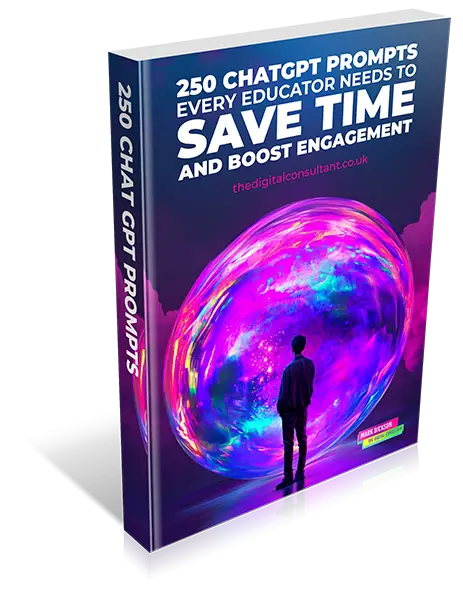If you’ve been teaching for any length of time, I bet you’ve heard the phrase Stretch and Challenge more times than you’ve had hot dinners! It comes up in meetings, CPD sessions and Ofsted reports. But all too often, it gets reduced to a checkbox task or a last-minute extension activity for students who finish early.
It’s time we change that.
Stretch and Challenge is not a bolt-on. It is a mindset. A way of embedding high expectations into every part of your teaching. Done well, it transforms your classroom into a space where every student, whatever their starting point, builds resilience, develops deeper thinking and sees themselves as capable of success.
If your goal is to create lessons that encourage effort, resilience and success for all students, whether you teach in schools, further education or adult learning, this guide will show you ways to make it happen.
What Stretch and Challenge Really Looks Like
At its heart, Stretch and Challenge is about creating an environment where every student is expected to think harder, develop independence and aim higher. It’s not about doing more, it’s about doing better, deeper work.
Shift from Extension to Expectation
Too many classrooms still treat challenge as something that happens after the “core” learning. Megan Mansworth challenges this directly in Teach to the Top, advocating for pitching the main teaching to a high level from the outset. Instead of tacking challenge onto the end of your session (you know what I mean here… “If you’ve finished the task you can try and tackle the extension task – it’s a red chilli on the chilli scale…”), you teach to the top and use scaffolding and strategies to support students to reach it.
How to implement:
- Start by modelling high-quality answers and thinking processes. Use examples that demonstrate advanced vocabulary, analytical thinking and well-structured reasoning.
- Use ‘challenge questions’ as the norm, not the exception. Instead of “if you finish early,” these should be front-loaded into your questioning.
- Include challenge walls or challenge stations in your classroom, where any student can access high-level thinking tasks throughout the lesson.
This approach benefits every student by setting a classroom culture where high performance is expected, not optional.
High Expectations for All Students
Dr Christine Rubie-Davies’ research on high expectation teaching shows that teachers who consistently expect more from their students achieve better outcomes across all ability groups. Her findings highlight three specific areas that transform classroom practice:
- Mixed-attainment groupings, rather than static ability groups, to keep expectations high for everyone.
- A strong classroom community, where effort and learning growth are consistently celebrated.
- Using individual goal setting to promote student autonomy and ownership of learning.
How to implement:
- Mix up your groupings regularly, so students don’t get fixed ideas about their place in the class hierarchy.
- Build a positive classroom climate by celebrating effort, process and resilience. Praise students for grappling with challenge, not just getting things right.
- Set personal learning goals with students, linked to progress and effort rather than just outcomes.
This reinforces the idea that every student can achieve at a high level, rather than segregating challenge by prior attainment.
Embedding Challenge in the Lesson Structure
Drawing from Teach Like a Champion (Doug Lemov), techniques like ‘Stretch It’, ‘Right is Right’ and ‘Cold Call’ give you everyday tools to embed challenge consistently. The goal is to make challenge part of the classroom rhythm.
How to implement:
- Use Cold Call to include all students in high-level questioning, not just those who put their hands up. This is one of the simplest fixes I see in most classrooms that could be improved with absolutely no extra work for you.
- Follow up correct answers with ‘Stretch It’ questions. For example: “Great, now can you explain why that’s the case?”, “Can you give me a contrasting example?” or “Can you summarise that using subject-specific vocabulary?”. I recently saw a brilliant session where the teacher never told the students they were right or wrong when they answered a question, instead he asked the students ‘Is she right? Tell me how’. It was amazing to see the students deepen their thinking.
- Set up ‘No Opt Out’ expectations, where you always circle back to students to ensure everyone reaches the answer, supporting when necessary.
This normalises challenge across the lesson rather than limiting it to a single point or group of students.
Practical Classroom Strategies to Embed Stretch and Challenge
So let’s look at what you can do immediately in your sessions to stretch students’ thinking, reduce passive learning and maximise engagement for all levels of ability.
1. Start with High-Quality Modelling
Why it works: Modelling expert thinking raises the ceiling for what students think they can achieve.
- Model top-grade responses with your students and break down why it works. Narrate the thought process, language choices and reasoning.
- Show how to edit and improve answers live so students see challenge as part of the learning process.
- Borrowing from Teach to the Top, keep a Challenge Modelling Bank – a selection of model answers or worked examples you can refer to regularly.
Impact: Students get a clear benchmark of high performance and gain the strategies to reach it.
2. Use Probing and Follow-Up Questions
From Teach Like a Champion (Doug Lemov):
- Use Stretch It to ask follow-up questions that deepen responses.
- Example: “That’s a good point, can you connect it to yesterday’s lesson?” or “Can you challenge that idea with a counter-example?”
From Teach to the Top:
- Probing questions should be routine, not exceptional.
- Build in oral rehearsal where students talk through their reasoning before writing.
Impact: You are training students to extend their thinking, not just answer the first layer of a question.
3. Build Thinking Time and Think-Pair-Share Routines
Why it works: High challenge requires processing time. Students need space to think before responding.
- Always include at least 5 seconds of wait time after asking a question.
- Use Think-Pair-Share so every student engages with the question before a whole-class discussion.
- Encourage ‘Challenge Talk’ where students build on each other’s answers, refining or challenging them.
Christine Rubie-Davies points to the importance of classroom dialogue in building high expectations and student confidence.
Impact: Students are less reliant on guessing and more focused on developing ideas.
4. Replace Ability Groupings with Flexible Challenge Options
Rubie-Davies’ evidence is clear: mixed groupings lead to higher gains, especially for students who were previously seen as “lower ability”.
- Avoid fixed “top group” labels.
- Use collaborative problem-solving, jigsaw tasks and reciprocal teaching strategies where students learn from each other.
- Provide opt-in challenge tasks. Any student can access the more challenging material, not just a select few.
Impact: You prevent students from limiting themselves based on perceived ability.
5. Make Challenge Visible in the Environment
From Teach to the Top:
- Create a Challenge Zone or Challenge Wall where high-level thinking prompts, ambitious vocabulary and complex tasks are always accessible.
- Have a ‘Why is this important?’ board where students contribute reflections on how skills connect to real life or future learning.
Impact: Students internalise the normality of challenge and begin to take ownership of it.
6. Personal Goal-Setting and Self-Reflection
From Christine Rubie-Davies:
- High expectation classrooms include student-led goal setting.
- Use quick reflection routines like ‘One thing I improved on today was…’ and ‘One thing I will aim for next lesson is…’
- Tie personal goals to specific skills or habits, not just grades.
Impact: You build student ownership of progress, helping them develop self-efficacy and resilience.

Common Mistakes with Stretch and Challenge (And What To Do Instead)
When you start making Stretch and Challenge a consistent part of your lessons, some patterns crop up. I’ve made these mistakes myself and seen them crop up with colleagues, especially when the pressure’s on to “show” challenge in a lesson visit (proving but not improving!). Here’s what to watch out for, with fixes you can use straight away.
Mistake 1: Making Challenge About ‘More Work’
It’s really easy to slip into the habit of stretching students by giving them extra sheets or finishing early tasks. The problem? This sends the message that challenge is an add-on, rather than part of the learning.
What to do instead:
- Keep the main task pitched high from the start. Use questions and scaffolds to get everyone there.
- Have students refine and improve work, not just extend it. For example, “Now redraft it for a professional audience,” or “Rewrite using three key subject terms.”
Mistake 2: Saving Challenge for Confident Students
Sometimes without meaning to, challenge gets aimed at the students who seem the quickest or most articulate. This can leave others switched off or playing it safe.
This is a common pattern in lessons. The students who are quick to answer or naturally vocal often end up getting the lion’s share of the challenge. They are the ones who are asked to expand, justify or go deeper. Others in the room can get left behind, not because they are not capable, but because they are not as visible.
A few weeks ago, I saw a session where this really stood out. It was obvious who the teacher thought were the ‘high achievers’. They answered most of the questions and were regularly invited to justify or develop their responses. When we met for coaching, I asked if I could guess who she believed her strongest students were. She said yes, and I got every name right. I had done a quick heat map during the session, tallying how many response opportunities each student had. Sharing that visual helped her step back and see how much of the challenge had been directed towards a few students.
This kind of self-audit is a helpful reality check. It is not always about intention, it is often about habit.
What to do instead:
- Be deliberate with your questioning. Plan who you want to stretch in advance, not just who puts their hand up.
- Ask the more challenging questions across the whole group, not just the confident few.
- Give everyone time to rehearse a response before you take answers. That way, more students are ready to contribute and you can target your follow-up more widely.
- Aim high first, then provide support or scaffolds to help students build up to it if needed.
Mistake 3: Rushing Students Through Thinking
When students struggle, it’s tempting to jump in with help too soon. But this removes the chance for real struggle and deeper thinking.
What to do instead:
- Build in thinking time as a non-negotiable. Even 20–30 seconds of silent thinking can make a big difference.
- Give prompts like, “I’ll wait, you’ve got this,” or “Jot down two possible approaches before I hear your answer.”
Mistake 4: Thinking Challenge Means Complexity
Not every challenge needs to be a mind-bending essay question. Sometimes, the best challenge comes from applying simple knowledge in more complex situations.
What to do instead:
- Use transfer tasks: “How would this idea apply in a real-world scenario?” or “How would you explain this concept to someone with no subject knowledge?”
- Set up comparison tasks, like, “What’s the key difference between this example and the one we did last lesson?”
Mistake 5: Focusing Only on Written Work
It’s common to think of challenge as something that comes through harder questions or written tasks. That can cause you to overlook discussion, dialogue, and collaborative thinking.
What to do instead:
- Use paired reasoning, group problem-solving and oral rehearsals to stretch thinking before writing begins.
- Build in peer questioning sessions where students come up with challenging questions for each other.
If you’ve found yourself doing some of these things, you’re in good company. The fix is always the same: keep challenge as part of your core teaching, make it visible to all students, and don’t feel you need to overcomplicate it.
Making Stretch and Challenge Part of Your Long-Term Planning
Stretch and Challenge works best when it’s built into your overall planning, not just individual lessons. When it runs through your scheme of work, it becomes part of the classroom culture. Students come to expect it, rather than seeing it as something extra you bolt on every now and then.
Start With High Expectations
When you’re planning a unit, think about what real success looks like. Ask yourself, “What would an advanced student be doing by the end of this unit?” That’s your stretch point. Then work backwards, planning stepping stones to help everyone work towards it.
- Make sure your main tasks have depth, not just coverage. That could be analysing case studies, applying theories, or linking knowledge across topics.
- The key is to plan for everyone to reach a high point, not just a few.
Sequence Challenge, Not Just Content
It’s easy to get stuck on ticking off content, especially with tight deadlines. But it’s just as important to think about how the challenge ramps up over time.
- Plan tasks that gradually get harder or more independent. Start with structured tasks, then shift towards more open-ended ones.
- Build in ‘stretch milestones’ where students do something more demanding than they would’ve thought possible a few weeks before.
Make Space for Independence
Stretch doesn’t always come from harder questions. Sometimes, it’s about students applying learning by themselves without you jumping in too soon.
- As your unit goes on, plan in independent projects, critiques, or real-world tasks.
- Set up peer feedback sessions, so students are pushing each other to improve.
This way, challenge becomes something students own, not something you always have to drive.
Use Reflection to Push Progress
Reflection is a brilliant way to keep students focused on their own growth.
- After a big task, ask, “What did you get better at this time?” or “What’s your next challenge?”
- Use short reviews like ‘Even Better If…’ after projects so students are always thinking about how to push themselves further.
When you weave Stretch and Challenge into the long-term plan, it stops feeling like an afterthought. It becomes part of how you teach and how your students learn. That’s when you’ll really see confidence and ambition grow across the board.
Want the Research? Start With These Evidence-Based Resources
Barkley, E.F., Major, C.H. and Cross, K.P. (2014) Collaborative Learning Techniques: A Handbook for College Faculty. San Francisco: Jossey-Bass. Available at: https://amzn.to/469SfjU
A useful guide for building structured collaborative tasks that encourage deeper thinking and problem solving across different subjects.
Chartered College of Teaching (2019) Great teaching techniques: Stretch and challenge. Available at: https://my.chartered.college/research-hub/great-teaching-techniques-stretch-and-challenge/
A concise and practical overview of teaching strategies to promote stretch and challenge at all levels, with examples drawn from classroom practice.
Lemov, D. (2021) Teach Like a Champion 3.0: 63 Techniques That Put Students on the Path to College. Hoboken: Jossey-Bass. Available at: https://amzn.to/468Pb7F
Doug Lemov’s highly practical book covers effective questioning techniques like ‘Stretch It’ and ‘Right is Right’, helping teachers embed academic challenge into everyday classroom routines.
Mansworth, M. (2021) Teach to the Top: Aiming High for Every Learner. Woodbridge: John Catt Educational. Available at: https://amzn.to/4kA7dDa
A highly practical guide that focuses on embedding high challenge into lessons through curriculum planning, academic vocabulary and independent learning strategies.
Rubie-Davies, C.M. (2014) Becoming a High Expectation Teacher: Raising the Bar. London: Routledge. Available at: https://amzn.to/4eKLnvs
Christine Rubie-Davies explores how teacher expectations directly affect student outcomes, with clear strategies to raise expectations and avoid ability grouping traps.
Sherrington, T. (2017) The Learning Rainforest: Great Teaching in Real Classrooms. Woodbridge: John Catt Educational. Available at: https://amzn.to/40iyHGb
Tom Sherrington provides a practical framework for embedding high expectations and academic challenge within a supportive classroom environment.
Structural Learning (2021) Stretch and challenge: A teacher’s guide. Available at: https://www.structural-learning.com/post/stretch-and-challenge-a-teachers-guide/
A teacher-friendly guide to designing stretch and challenge activities, with useful examples of oracy tasks and scaffolded questioning approaches.
**Quick heads-up: some links on this page are Amazon affiliate links. If you click and buy, I get a small commission (it doesn’t cost you anything extra). Thanks for supporting the site!






